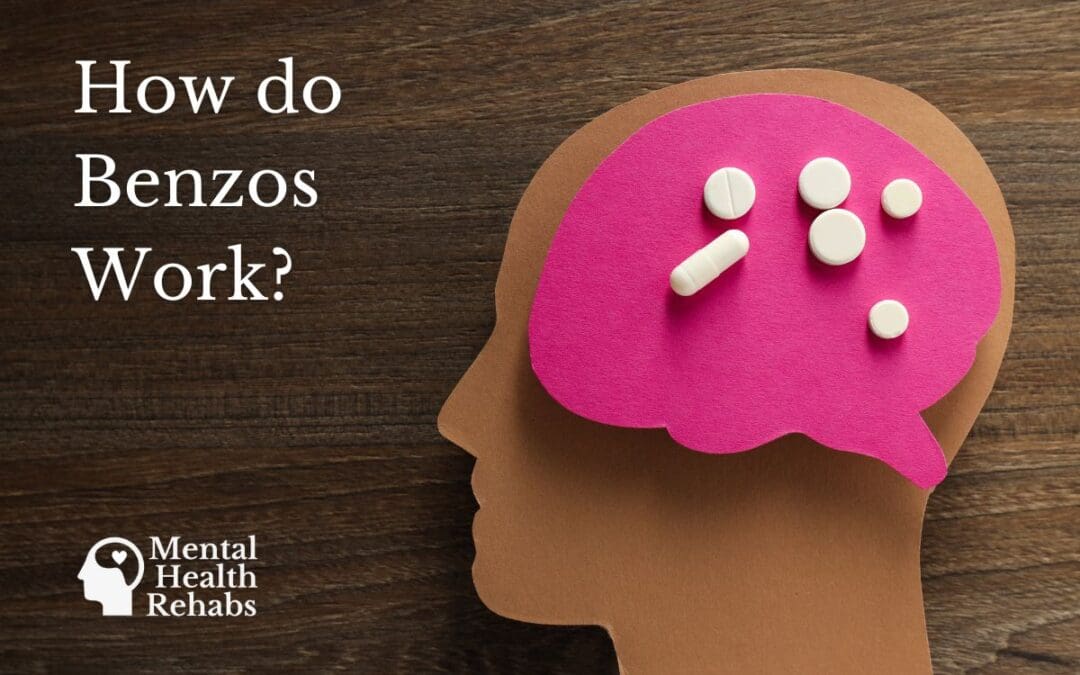Benzodiazepines, or “benzos”, are a class of medications commonly prescribed to treat anxiety disorders, insomnia, muscle spasms, and seizures. These medications work by targeting specific receptors in the brain, resulting in therapeutic effects similar to those of their pharmacological predecessors, barbiturates. They were introduced as a safer alternative to barbiturates which carried higher risks of addiction and drug interaction, as well as potentially excessive sedative effects. Still, benzodiazepines can carry some risks.
How Benzodiazepines Work
Benzodiazepines exert their effects by enhancing the actions of a naturally occurring neurotransmitter called gamma-aminobutyric acid (GABA). GABA is an inhibitory neurotransmitter that helps regulate brain activity and reduce neuronal excitability, resulting in a calming effect.
First, benzodiazepines bind to specific receptors called benzodiazepine receptors located on GABA-A receptors in the brain. These receptors are primarily found in areas involved in anxiety regulation, such as the limbic system.
This binding enhances the activity of GABA, where a number of molecular reactions take place which decrease neuronal excitability thereby dampening the transmission of signals in the brain. The results are a sedative effect. The increased inhibition of brain activity helps alleviate anxiety, induce relaxation, and promote sleep.
A shortage of GABA can lead to neurons firing too often and prevent the body from coming down from a physiological stature of heightened activity. These shortages have been shown to have a direct correlation with conditions such as anxiety and panic disorders, seizure disorders, and Parkinson’s syndrome. Benzodiazepines remedy this exact issue, which is why they are such effective medications.
The Different Types of Benzodiazepines
Benzodiazepines are primarily differentiated and classified based on how long the medication remains effective in the body, whether they are short-acting, intermediate-acting, or long-acting. This largely shapes what condition a certain type of benzo is safe to treat.
Long-acting benzodiazepines have a slower onset of action and a longer duration of effect, ranging between 1-3 days. Such extended duration makes this type of benzo ideal for the management of chronic conditions.
Intermediate-acting benzodiazepines have a duration between 11-20 hours (most of the types of benzodiazepine medications fall within this category) while short-acting benzodiazepines only have a duration between 3-8 hours. Typically, the shorter the duration of effect, the faster onset (amount of time until the drug exerts effects). Short-acting benzodiazepines are primarily used for short-term treatment of insomnia.
Understanding the differences between long and short-acting benzodiazepines is crucial for safe use that minimizes the risk of adverse effects, drug interactions, or addiction.
Benzodiazepines Uses & Benefits
Benzodiazepines can be used to treat an impressively wide variety of medical conditions due to their sedative, muscle relaxant, and anticonvulsant properties (there are over 30 different types of benzos!) Some of the primary uses of benzodiazepines include:
Anxiety Disorders
Benzodiazepines exert a calming effect and as such, are the most widely prescribed medication for treating anxiety. They are used to alleviate symptoms of generalized anxiety disorder (GAD), panic disorder, social anxiety disorder, and specific phobias. These medications help reduce excessive anxiety and promote relaxation within as little as 30 minutes.
Types of benzodiazepines used for panic or anxiety attacks: Ativan, Librium, Tranxene, Valium, Versed, Xanax
Insomnia
Benzodiazepines can be helpful for short-term management of insomnia, particularly when associated with anxiety or difficulty falling asleep. By enhancing GABA activity, benzodiazepines reduce the time it takes to fall asleep (sleep latency) while also increasing total sleep time.
However, due to the risk of dependence and rebound insomnia, benzodiazepines are typically prescribed for short durations and in lower doses. They are most effective when used as part of a comprehensive treatment plan that includes sleep hygiene practices and behavioral interventions.
Types of benzodiazepines used for insomnia: Dalmane, Doral, Estazolam, Halcion, Restoril
Muscle Spasms & Seizures
Benzodiazepines have muscle relaxant properties, making them effective in treating conditions such as muscle spasms, tension headaches, spasticity associated with neurological conditions, and temporomandibular joint disorder (TMJ). They can do so by enhancing GABA activity, which in turn decreases the excitability of motor neurons in the spinal cord, making them fire less frequently.
Reducing neuronal excitability also helps prevent the spread of abnormal electrical activity that underlies seizures, which enables benzodiazepines to also be used as an anticonvulsant medication to prevent and treat seizures, including epileptic seizures and febrile seizures in children. In emergency situations, benzodiazepines such as diazepam or lorazepam are often administered intravenously to rapidly terminate acute seizures.
Type of benzodiazepines used for spasms or seizures: Ativan, Klonopin, Onfi, Tranxene, Valium
Other Uses for Benzodiazepines
In addition to the above FDA-approved indications, benzodiazepines also have several off-label uses (uses for treating conditions it wasn’t officially approved for) such as tic disorders, bipolar disorder, restless leg syndrome, an anesthetic, and even alcohol withdrawal.
If you suffer from any of the listed conditions and think benzodiazepines could help, talk to a mental health professional today for a better idea of how benzodiazepines could work for your specific situation.
Sources:
https://wa.kaiserpermanente.org/static/pdf/public/guidelines/benzo-zdrug.pdf

